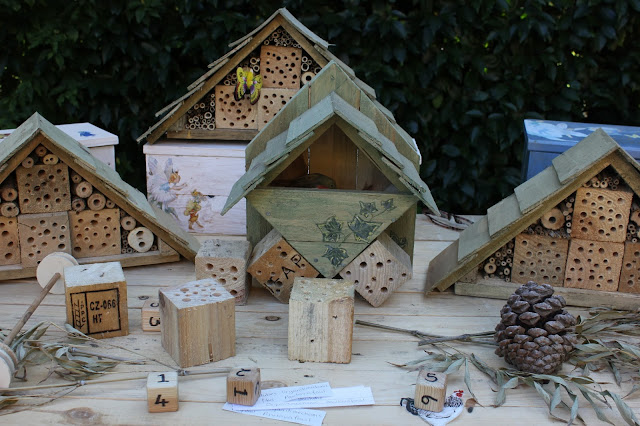We have been invited, once again, to an ‘Art in the Garden’ event in June. We usually take along a whole host of examples of our recuperation projects some of which are for sale. The ever-popular insect houses will be displayed in their various forms and in addition, for the more Do-it-yourself visitor there will be available the drilled wooden blocks for them to make their own versions.
I consider the blocks to be the best way of furnishing ‘instant’ insect accommodation but they can be tedious to produce and for the ill-equiped or ‘non-DIY’er’ they are not easy to make.
Also last year I was asked to make a cover for a very ugly utilities box (3 part article here) and we came up with the idea of designing an insect hotel, which would not only hide it but also have a function within the garden. This too required a whole raft of pallet wood blocks.
To this end, I drill several score of these recuperated un-treated wood pallet blocks which amounts to hundreds of holes of 2 or 3 different diameters. I only have a small, short stroke hand drill drill press so I am able to drill the holes in the blocks to a depth of 50mm (2”). I then complete the drilling by hand-holding the drill, the hole continues to run vertically being guided by the pre-drilled hole. The block needs to be held during this latter operation but the time taken to secure it using conventional G-clamps or vices can make the job take twice as long.
I came up with this simple wooden clamp which is fast and effective and cost me nothing to make!
The Clamp
The device is simply a cam mounted via a pivot to a wooden baseboard. On the flat-face at the cam’s rear is an operating lever of wood 40-50cm (roughly 18”) long.
The cam is made from a piece of pallet ‘stretcher’ 35mm (1½”) thick. I used a jigsaw to cut a curved face on one side of it and smoothed any irregularities with a belt sander.
On the side of the block opposite to the curved face I screwed a length of 45mm (1¾”) x 25mm (1”) timber which acts as the operating lever. The cam was attached to the plywood base with a 6mm (¼”) x 70mm (2¾”) coach bolt.
A piece of pallet stringer wood 14cm (5½”) long was screwed to the baseboard opposite to the cam’s curved face., this acted as the second jaw for the clamp, the first jaw being the cam. The distance between it and the face of the cam at the cam’s minimum separation from the block was set to be just less than the size of a wooden pallet block
Operation

To use the device, the base was secured to a “Workmate” workbench using a g-clamp. To prevent the device rotating when in action, the nut holding the coach bolt in place was rested against the “Workmate” jaw face such that the nut acted as a stop.
The operating lever was extended over the front edge of the “Workmate” and moved such that the gap between the cam face and the wooden jaw was at a maximum.
A pallet block, pre-drilled using the drill stand, was placed in the clamp gap and the lever moved clockwise so as to bring the cam’s curved face to bear on it. Clamping force was applied and maintained simply by leaning on the lever with one’s leg, leaving the hands free to safely operate the (now hand-held) drill.
The great thing about the clamp is that as long as you’re applying pressure on the lever, the block will not move. As a consequence of the design blocks of differing sizes may also be securely held.
Now if you'd like to,
sit back and watch the clamp in action:
Now if you'd like to,
sit back and watch the clamp in action:
All the best and thanks for dropping by. Please feel free to share this article, comment and/or ask for further information.
Cheers, Andy
Related Posts
 A step-by-step tutorial for our Luxury Insect Hotel for discerning arthropods (shown left) and two simpler but effective designs for Mason bees and lacewings, follow this link for The Gîte & the Chalet (Chalet pictured right).
A step-by-step tutorial for our Luxury Insect Hotel for discerning arthropods (shown left) and two simpler but effective designs for Mason bees and lacewings, follow this link for The Gîte & the Chalet (Chalet pictured right). 











Excellent clamp, I have a few bought clamps, but more often than not they aren't quite right for a particular job, this looks like a quick and easy way to solve that problem.
ReplyDeleteThank-you my friend for your kind comments. I'm really sorry I only just found them and they are very much appreciated! I love these simple old solutions from a time when people made their own tools to fit the specific job - I think we will see more of them in the future too! All the very best, Andy
Delete